
Paul Casey’s victory at this summer’s Irish Open was the final straw the R&A needed to make overdue changes to qualifying for The Open.
Casey won in Ireland just over a fortnight before the Claret Jug battle at Muirfield. But he didn’t earn a spot at the main event because he had failed to make it through a 36-hole qualifier a few days before.
That highlighted the system was wrong.
The R&A wants its flagship event to have the strongest field possible. To do that, you want the star names and guys in form. Now, ineligible players can earn one of three spots available at each of the Irish, French and Scottish Opens, and at other tournaments around the world. But the places aren’t being handed out like confetti. Players must finish in the top 12 to have any chance.
This system is much fairer. To gain a place at the world’s premier event, you must prove your worth over 72 holes with good golf. However, it’s sad to see the end of Local Final Qualifying at links courses near The Open venue.
There was something romantic about seeing the likes of former Masters Champion Ben Crenshaw once trying to qualify alongside club pros and budding amateurs at North Berwick.
But everyone will be happy to see the back of the 36-hole Monday ‘shoot-outs’. Players arrive late and tired from a tournament on Sunday, and have no chance to practice. Then it’s up early the next day as 96 compete for 10 or 11 places in a total lottery. A bad start and you’re out of it, so it’s no surprise that so many walk off or don’t play the second 18.
Speaking of walking off, Joost Luiten’s actions at last week’s BMW Masters in Shanghai have really sparked a debate. He had injured his shoulder and couldn’t really play, but he hit his opening tee shot 120 yards and that was it.
Luiten is having a great season and is desperate to be involved in the Race to Dubai Final. But to do that, he must play two of the other three events in the European Tour’s new Final Series. Walking off after one shot isn’t ideal, but in this case, he felt he had no alternative.
And with these new rules in place, if the Dutchman hasn’t fully recovered, he might do the same at this week’s Turkish Open.
However, I have little sympathy for first reserve, Justin Walters, who complained about Luiten’s actions. He had ample chance all season to qualify for this tournament by right, but didn’t. As reserve, you are banking on misfortune for a fellow pro to get your chance.
It’s a bit of luck, not a divine right, to have the opportunity to tee it up.

Enjoy the convenience of having The Sunday Post delivered as a digital ePaper straight to your smartphone, tablet or computer.
Subscribe for only £5.49 a month and enjoy all the benefits of the printed paper as a digital replica.
Subscribe